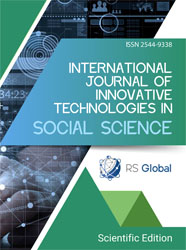THE ROLE OF BACTERIAL BIOFILM IN REFRACTORY CHRONIC RHINOSINUSITIS: A NARRATIVE REVIEW
Abstract
Objectives: Chronic Rhinosinusitis (CRS) is a common inflammatory disease impacting 5-12% of the population, leading to substantial morbidity and healthcare expenses. Bacterial biofilms on the sinonasal mucosa are a key factor in CRS's development, persistence, and resistance to treatment. This review explores their role in refractory CRS, focusing on structure, formation, impact on severity, and diagnostic/therapeutic approaches.
Methods: We conducted a comprehensive literature review using PubMed, Scopus, and Web of Science, searching for keywords related to CRS, bacterial biofilms, antibiotic resistance, and therapies. We prioritized studies from the last decade examining biofilms' impact on CRS pathogenesis, resistance, and novel treatments.
Key findings: Biofilms, organized microbial communities within an extracellular polymeric matrix, are significantly more resistant to antibiotics and host immune responses than free-floating bacteria. They form through stages: initial attachment, proliferation, and complex 3D structure development, with quorum sensing vital for maturation. Common CRS biofilm pathogens include Staphylococcus aureus, Pseudomonas aeruginosa, and Haemophilus influenzae. Biofilms correlate with more severe disease, poorer surgical outcomes, and higher recurrence. Diagnostics include electron microscopy, confocal laser scanning microscopy (CLSM), and molecular methods. Treatment involves surgical removal, topical antibiotics, and novel strategies like phage therapy, quorum sensing inhibitors, and micro-biome-based interventions.
Conclusions: Biofilms are critical in refractory CRS, causing persistence, treatment resistance, and worse outcomes. A deep understanding of biofilm mechanisms is crucial for effective diagnostics and therapies. Future research should standardize diagnostics, clarify biofilm-host interactions, and conduct trials on new, personalized biofilm-targeting treatments.
References
Boase, S., Foreman, A., Cleland, E. J., Tan, L., Melton-Kreft, R., Pant, H., Hu, F., Ehrlich, G.D., & Wormald, P. (2013). The microbiome of chronic rhinosinusitis: culture, molecular diagnostics and biofilm detection. BMC Infectious Diseases, 13(1). https://doi.org/10.1186/1471-2334-13-210
Brackman, G., & Coenye, T. (2014). Quorum Sensing Inhibitors as Anti-Biofilm Agents [Review of Quorum Sensing Inhibitors as Anti-Biofilm Agents]. Current Pharmaceutical Design,21(1),5. Bentham Science Publishers.https://doi.org/10.2174/1381612820666140905114627
Chalermwatanachai, T., Vilchez‐Vargas, R., Holtappels, G., Lacoere, T., Jáuregui, R., Kerckhof, F., Pieper, D. H., Wiele, T. V. de, Vaneechoutte, M., Zele, T. V., & Bachert, C. (2018). Chronic rhinosinusitis with nasal polyps is characterized by dysbacteriosis of the nasal microbiota. Scientific Reports, 8(1). https://doi.org/10.1038/s41598-018-26327-2
Długaszewska, J., Leszczyńska, M., Lenkowski, M., Tatarska, A., Pastusiak, T., & Szyfter, W.(2015). The pathophysiological role of bacterial biofilms in chronic sinusitis. European Achives of Oto-Rhino-Laryngology, 273(8), 1989. https://doi.org/10.1007/s00405-015-3650-5
Empitu, M. A., Kadariswantiningsih, I. N., & Shakri, N. M. (2025). Pharmacological strategies for targeting biofilms in otorhinolaryngologic infections and overcoming antimicrobial resistance (Review) [Review of Pharmacological strategies for targeting biofilms in otorhinolaryngologic infections and overcoming antimicrobial resistance (Review)]. Biomedical Reports, 22(6), 1. Spandidos Publishing. https://doi.org/10.3892/br.2025.1973
Fastenberg, J. H., Hsueh, W. D., Ali, M., Akbar, N., & Abuzeid, W. M. (2016). Biofilms in chronic rhinosinusitis: Pathophysiology and therapeutic strategies [Review of Biofilms in chronic rhinosinusitis: Pathophysiology and therapeutic strategies]. World Journal of Otorhinolaryngology - Head and Neck Surgery, 2(4), 219. KeAi. https://doi.org/10.1016/j.wjorl.2016.03.002
Feazel, L. M., Robertson, C. E., Ramakrishnan, V. R., & Frank, D. N. (2012). Microbiome complexity and Staphylococcus aureus in chronic rhinosinusitis. The Laryngoscope, 122(2), 467. https://doi.org/10.1002/lary.22398
Foreman, A., Psaltis, A. J., Tan, L. W., & Wormald, P. (2009). Characterization of Bacterial and Fungal Biofilms in Chronic Rhinosinusitis. American Journal of Rhinology and Allergy, 23(6), 556. https://doi.org/10.2500/ajra.2009.23.3413
Hildenbrand, T., Milger, K., Baumann, I. go, & Weber, R. (2024). The diagnosis and treatment of chronic rhinosinusitis [Review of The diagnosis and treatment of chronic rhinosinusitis]. Deutsches Ärzteblatt International. Deutscher Ärzte-Verlag. https://doi.org/10.3238/arztebl.m2024.0167
Hoggard, M., Mackenzie, B. W., Jain, R., Taylor, M. W., Biswas, K., & Douglas, R. (2016). Chronic Rhinosinusitis and the Evolving Understanding of Microbial Ecology in Chronic Inflammatory Mucosal Disease [Review of Chronic Rhinosinusitis and the Evolving Understanding of Microbial Ecology in Chronic Inflammatory Mucosal Disease]. Clinical Microbiology Reviews, 30(1), 321. American Society for Microbiology. https://doi.org/10.1128/cmr.00060-16
Huang, Y., Qin, F., Li, S., Yin, J., Hu, L., Zheng, S., He, L., Xia, H., Liu, J., & Hu, W. (2022). The mechanisms of biofilm antibiotic resistance in chronic rhinosinusitis: A review [Review of The mechanisms of biofilm antibiotic resistance in chronic rhinosinusitis: A review]. Medicine, 101(49). Wolters Kluwer. https://doi.org/10.1097/md.0000000000032168
Kaliniak, S., Fiedoruk, K., Spałek, J., Piktel, E., Durnaś, B., Góźdż, S., Bucki, R., & Okła, S. (2024). Remodeling of Paranasal Sinuses Mucosa Functions in Response to Biofilm-Induced Inflammation. Journal of Inflammation Research, 1295. https://doi.org/10.2147/jir.s443420
Kariyawasam, H. H., & Scadding, G. (2011). Chronic Rhinosinusitis: Therapeutic Efficacy of Anti-Inflammatory and Antibiotic Approaches. Allergy Asthma and Immunology Research, 3(4), 226. https://doi.org/10.4168/aair.2011.3.4.226
Koefoed, A., Mackenzie, B. W., Douglas, R., & Biswas, K. (2023). Current evidence of biofilms in chronic rhinosinusitis- a microbiological perspective [Review of Current evidence of biofilms in chronic rhinosinusitis- a microbiological perspective]. Expert Review of Clinical Immunology, 19(8), 911. Taylor & Francis. https://doi.org/ 10.1080/1744666x.2023.2231153
Lam, K., Schleimer, R. P., & Kern, R. C. (2015). The Etiology and Pathogenesis of Chronic Rhinosinusitis: a Review of Current Hypotheses [Review of The Etiology and Pathogenesis of Chronic Rhinosinusitis: a Review of Current Hypotheses]. Current Allergy and Asthma Reports, 15(7). Springer Science+Business Media. https://doi.org/10.1007/s11882-015-05402
Mahdavinia, M., Keshavarzian, A., Tobin, M. C., Landay, A., & Schleimer, R. P. (2015). A comprehensive review of the nasal microbiome in chronic rhinosinusitis (CRS) [Review of A comprehensive review of the nasal microbiome in chronic rhinosinusitis (CRS)]. Clinical & Experimental Allergy, 46(1), 21. Wiley. https://doi.org/10.1111/cea.12666
Maina, I. W., Patel, N. N., & Cohen, N. A. (2018). Understanding the Role of Biofilms and Superantigens in Chronic Rhinosinusitis. Current Otorhinolaryngology Reports, 6(3), 253. https://doi.org/10.1007/s40136-018-0212-6
Moulic, A. G., Deshmukh, P., & Gaurkar, S. (2024). A Comprehensive Review on Biofilms in Otorhinolaryngology: Understanding the Pathogenesis, Diagnosis, and Treatment Strategies [Review of A Comprehensive Review on Biofilms in Otorhinolaryngology: Understanding the Pathogenesis, Diagnosis, and Treatment Strategies]. Cureus. Cureus, Inc. https://doi.org/10.7759/cureus.57634
Ramakrishnan, V. R., Hauser, L. J., Feazel, L. M., Ir, D., Robertson, C. E., & Frank, D. N. (2015). Sinus microbiota varies among chronic rhinosinusitis phenotypes and predicts surgical outcome. Journal of Allergy and Clinical Immunology, 136(2), 334. https://doi.org/10.1016/j.jaci.2015.02.008
Sahreen, S., Mukhtar, H., Imre, K., Morar, A., Herman, V., & Sharif, S. (2022). Exploring the Function of Quorum Sensing Regulated Biofilms in Biological Wastewater Treatment: A Review [Review of Exploring the Function of Quorum Sensing Regulated Biofilms in Biological Wastewater Treatment: A Review]. International Journal of Molecular Sciences, 23(17), 9751. Multidisciplinary Digital Publishing Institute. https://doi.org/10.3390/ijms23179751
Shaghayegh, G., Cooksley, C., Ramezanpour, M., Wormald, P., Psaltis, A. J., & Vreugde, S. (2022). Chronic Rhinosinusitis, S. aureus Biofilm and Secreted Products, Inflammatory Responses, and Disease Severity [Review of Chronic Rhinosinusitis, S. aureus Biofilm and Secreted Products, Inflammatory Responses, and Disease Severity]. Biomedicines, 10(6), 1362. Multidisciplinary Digital Publishing Institute. https://doi.org/10.3390/biomedicines10061362
Shariati, A., Vesal, S., Khoshbayan, A., Goudarzi, P., Darban‐Sarokhalil, D., Razavi, S., Didehdar, M., & Chegini, Z. (2021). Novel strategies for inhibition of bacterial biofilm in chronic rhinosinusitis [Review of Novel strategies for inhibition of bacterial biofilm in chronic rhinosinusitis]. Journal of Applied Microbiology, 132(4), 2531. Oxford University Press. https://doi.org/10.1111/jam.15398
Shekhar, S., Schwarzer, M., Dhariwal, A., & Petersen, F. C. (2025). Nasal microbiota transplantation: a gateway to novel treatments. Trends in Microbiology. https:// doi.org/10.1016/j.tim.2024.12.010
Silva, N. B. S., Marqués, L. A., & Röder, D. D. B. (2021). Diagnosis of biofilm infections: current methods used, challenges and perspectives for the future [Review of Diagnosis of biofilm infections: current methods used, challenges and perspectives for the future]. Journal of Applied Microbiology, 131(5), 2148. Oxford University Press. https://doi.org/10.1111/jam.15049
Stevens, W. W., Lee, R. J., Schleimer, R. P., & Cohen, N. A. (2015). Chronic rhinosinusitis pathogenesis [Review of Chronic rhinosinusitis pathogenesis]. Journal of Allergy and Clinical Immunology, 136(6), 1442. Elsevier BV. https://doi.org/10.1016/j.jaci.2015.10.009
Vanderpool, E. J., & Rumbaugh, K. P. (2023). Host-microbe interactions in chronic rhinosinusitis biofilms and models for investigation [Review of Host-microbe interactions in chronic rhinosinusitis biofilms and models for investigation]. Biofilm, 6, 100160. Elsevier BV. https://doi.org/10.1016/j.bioflm.2023.100160
Wu, H., Moser, C., Wang, H., Høiby, N., & Song, Z. (2014). Strategies for combating bacterial biofilm infections [Review of Strategies for combating bacterial biofilm infections]. International Journal of Oral Science, 7(1), 1. Springer Nature. https://doi.org/10.1038/ijos.2014.65
Zabolotna, D., & Maliarenko, Y. (2024). Bacterial Biofilms in Chronic Rhinosinusitis. Clinical Role and Current Therapeutic Strategies. Mikrobiolohichnyi Zhurnal, 86(6), 115. https://doi.org/10.15407/microbiolj86.06.115
Zhang, K., Li, X., Yu, C., & Wang, Y. (2020). Promising Therapeutic Strategies Against Microbial Biofilm Challenges [Review of Promising Therapeutic Strategies Against Microbial Biofilm Challenges]. Frontiers in Cellular and Infection Microbiology, 10. Frontiers Media. https://doi.org/10.3389/fcimb.2020.00359
Views:
952
Downloads:
841
Copyright (c) 2025 Oliwia Sójkowska-Sławińska, Tobiasz Sławiński, Anna Leśniewska, Patryk Macuk, Michał Gniedziejko, Jakub Roszak, Paulina Bernecka, Bartosz Michał Skorupski, Natalia Strumnik

This work is licensed under a Creative Commons Attribution 4.0 International License.
All articles are published in open-access and licensed under a Creative Commons Attribution 4.0 International License (CC BY 4.0). Hence, authors retain copyright to the content of the articles.
CC BY 4.0 License allows content to be copied, adapted, displayed, distributed, re-published or otherwise re-used for any purpose including for adaptation and commercial use provided the content is attributed.















